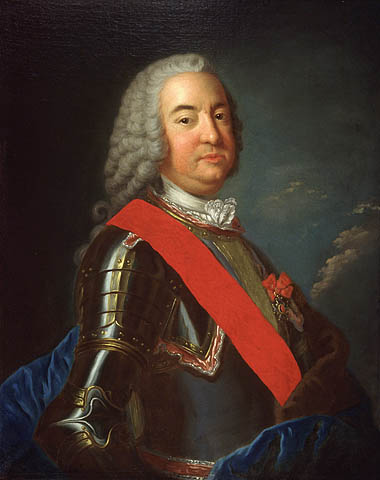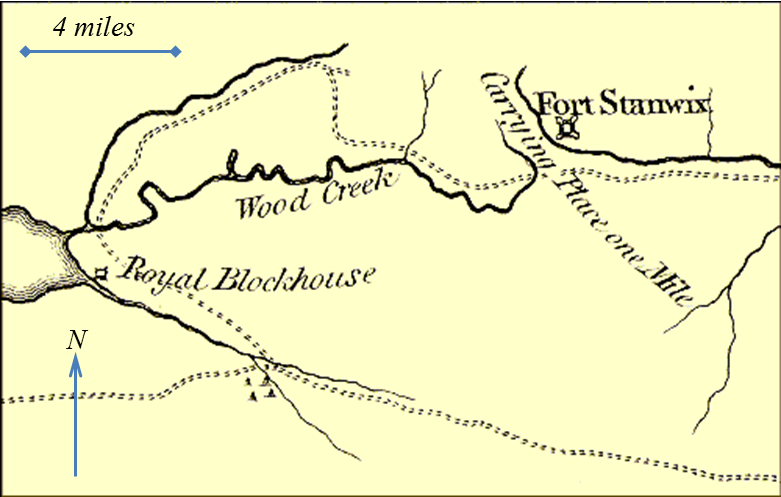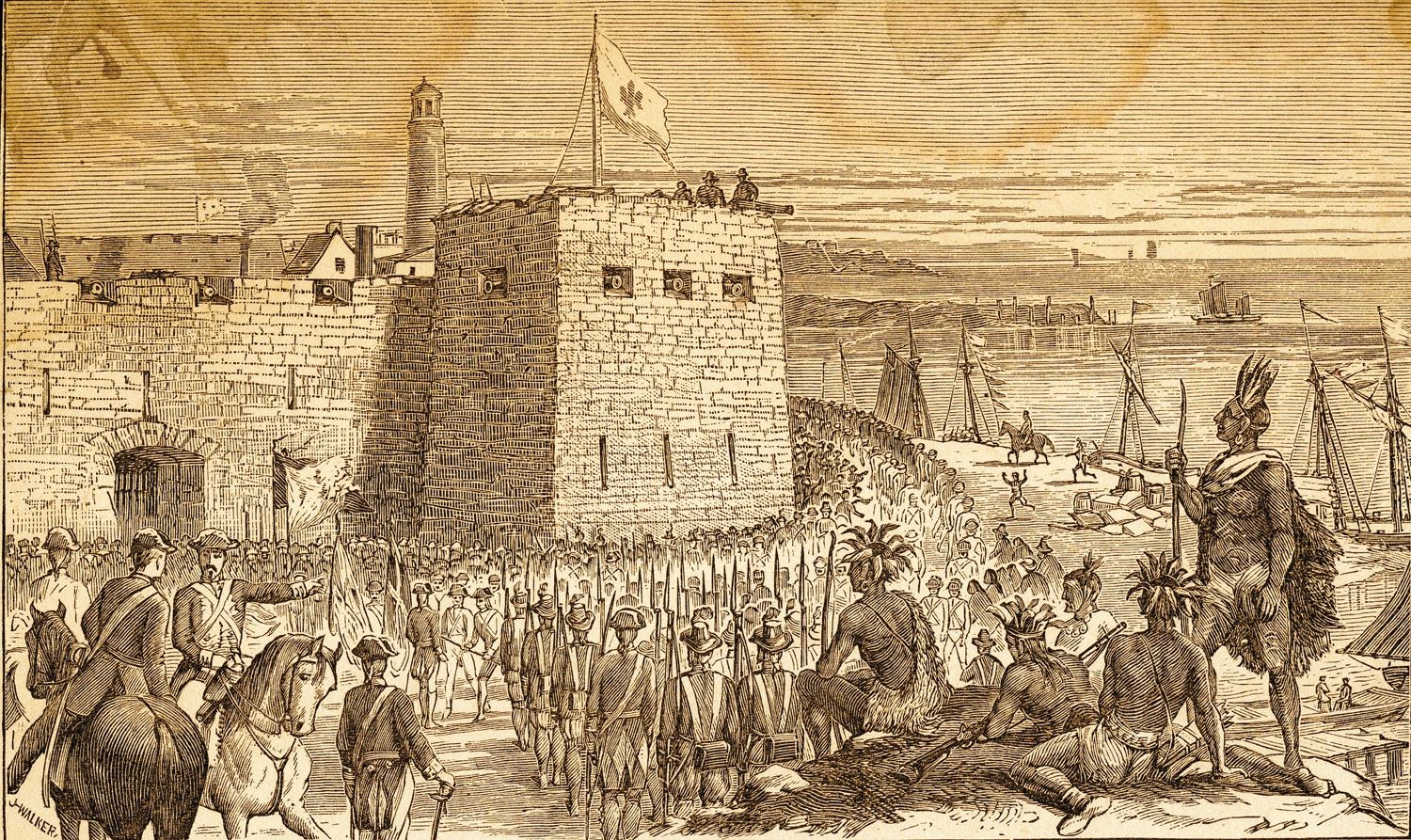|
Battle Of Fort Bull
The Battle of Fort Bull was a French attack on the British-held Fort Bull on 27 March 1756, early in the French and Indian War. The fort was built to defend a portion of the waterway connecting Albany, New York to Lake Ontario via the Mohawk River. Lt. Gaspard-Joseph Chaussegros de Léry led his command consisting of forces from the Troupes de la Marine, Canadien militia, and Indian allies on an attack against Fort Bull on 27 March 1756. Shielded by trees they sneaked up to within of the fort. Léry ordered a charge at the fort with bayonets. They stuck their muskets into the narrow openings in the fort and shot the defenders. Léry repeatedly asked for their surrender. Finally, the gate was crashed in and the French and Indians swarmed in, killing everyone they saw. The French soldiers looted what they could and set the powder magazines on fire. The fort was burned to the ground. Background The establishment of Fort Oswego (modern Oswego, New York) in the 1720s on the south sh ... [...More Info...] [...Related Items...] OR: [Wikipedia] [Google] [Baidu] |
French And Indian War
The French and Indian War (1754–1763) was a theater of the Seven Years' War, which pitted the North American colonies of the British Empire against those of the French, each side being supported by various Native American tribes. At the start of the war, the French colonies had a population of roughly 60,000 settlers, compared with 2 million in the British colonies. The outnumbered French particularly depended on their native allies. Two years into the French and Indian War, in 1756, Great Britain declared war on France, beginning the worldwide Seven Years' War. Many view the French and Indian War as being merely the American theater of this conflict; however, in the United States the French and Indian War is viewed as a singular conflict which was not associated with any European war. French Canadians call it the ('War of the Conquest').: 1756–1763 The British colonists were supported at various times by the Iroquois, Catawba, and Cherokee tribes, and the French ... [...More Info...] [...Related Items...] OR: [Wikipedia] [Google] [Baidu] |
Lake Ontario
Lake Ontario is one of the five Great Lakes of North America. It is bounded on the north, west, and southwest by the Canadian province of Ontario, and on the south and east by the U.S. state of New York. The Canada–United States border spans the centre of the lake. The Canadian cities of Toronto, Kingston, Mississauga, and Hamilton are located on the lake's northern and western shorelines, while the American city of Rochester is located on the south shore. In the Huron language, the name means "great lake". Its primary inlet is the Niagara River from Lake Erie. The last in the Great Lakes chain, Lake Ontario serves as the outlet to the Atlantic Ocean via the Saint Lawrence River, comprising the eastern end of the Saint Lawrence Seaway. The Moses-Saunders Power Dam regulates the water level of the lake. Geography Lake Ontario is the easternmost of the Great Lakes and the smallest in surface area (7,340 sq mi, 18,960 km2), although it exceeds Lake Eri ... [...More Info...] [...Related Items...] OR: [Wikipedia] [Google] [Baidu] |
Onondaga People
The Onondaga people (Onondaga: , ''Hill Place people'') are one of the original five constituent nations of the Iroquois (''Haudenosaunee'') Confederacy in northeast North America. Their traditional homeland is in and around present-day Onondaga County, New York, south of Lake Ontario. They are known as ''Gana’dagwëni:io’geh'' to the other Iroquois tribes. Being centrally located, they are considered the "Keepers of the Fire" (''’'' in Tuscarora) in the figurative longhouse that shelters the Five Nations. The Cayuga and Seneca have territory to their west and the Oneida and Mohawk to their east. For this reason, the League of the Iroquois historically met at the Iroquois government's capital at Onondaga, as the traditional chiefs do today. In the United States, the home of the Onondaga Nation is the Onondaga Reservation. Onondaga peoples also live near Brantford, Ontario on Six Nations territory. This reserve used to be Haudenosaunee hunting grounds, but much of the Con ... [...More Info...] [...Related Items...] OR: [Wikipedia] [Google] [Baidu] |
Marquis De Vaudreuil (1724 – 1802), French admiral, son of the former
{{hndis, Vaudreuil ...
The Marquis de Vaudreuil may refer to: *Philippe de Rigaud de Vaudreuil (1643–1702), governor of Montréal then of New France * Pierre de Rigaud de Vaudreuil (1698–1778), last governor-general of New France * Louis-Philippe de Rigaud, Marquis of Vaudreuil (1691 – 1763), French admiral *Louis-Philippe de Rigaud, Marquis de Vaudreuil Louis-Philippe de Rigaud, Marquis de Vaudreuil (18 April 1724 – 14 December 1802) was second in command of the French squadron off America during the American Revolutionary War. Biography Early life Louis-Philippe Rigaud de Vaudreuil was ... [...More Info...] [...Related Items...] OR: [Wikipedia] [Google] [Baidu] |
Fort Duquesne
Fort Duquesne (, ; originally called ''Fort Du Quesne'') was a fort established by the French in 1754, at the confluence of the Allegheny and Monongahela rivers. It was later taken over by the British, and later the Americans, and developed as Pittsburgh in the U.S. state of Pennsylvania. Fort Duquesne was destroyed by the French, prior to British conquest during the Seven Years' War, known as the French and Indian War on the North American front. The British replaced it, building Fort Pitt between 1759 and 1761. The site of both forts is now occupied by Point State Park, where the outlines of the two forts have been laid in brick. Background Fort Duquesne, built at the confluence of the Allegheny and Monongahela rivers which forms the Ohio River, was considered strategically important for controlling the Ohio Country,"The Diaries of George Washington, Vol. 1", Donald Jackson, ed., Dorothy Twohig, assoc. edLibrary of Congress American Memory site/ref> both for settlement ... [...More Info...] [...Related Items...] OR: [Wikipedia] [Google] [Baidu] |
Ammunition
Ammunition (informally ammo) is the material fired, scattered, dropped, or detonated from any weapon or weapon system. Ammunition is both expendable weapons (e.g., bombs, missiles, grenades, land mines) and the component parts of other weapons that create the effect on a target (e.g., bullets and warheads). The purpose of ammunition is to project a force against a selected target to have an effect (usually, but not always, lethal). An example of ammunition is the firearm cartridge, which includes all components required to deliver the weapon effect in a single package. Until the 20th century, black powder was the most common propellant used but has now been replaced in nearly all cases by modern compounds. Ammunition comes in a great range of sizes and types and is often designed to work only in specific weapons systems. However, there are internationally recognized standards for certain ammunition types (e.g., 5.56×45mm NATO) that enable their use across different weapo ... [...More Info...] [...Related Items...] OR: [Wikipedia] [Google] [Baidu] |
Gunpowder
Gunpowder, also commonly known as black powder to distinguish it from modern smokeless powder, is the earliest known chemical explosive. It consists of a mixture of sulfur, carbon (in the form of charcoal) and potassium nitrate (saltpeter). The sulfur and carbon act as fuels while the saltpeter is an oxidizer. Gunpowder has been widely used as a propellant in firearms, artillery, rocketry, and pyrotechnics, including use as a blasting agent for explosives in quarrying, mining, building pipelines and road building. Gunpowder is classified as a low explosive because of its relatively slow decomposition rate and consequently low brisance. Low explosives deflagrate (i.e., burn at subsonic speeds), whereas high explosives detonate, producing a supersonic shockwave. Ignition of gunpowder packed behind a projectile generates enough pressure to force the shot from the muzzle at high speed, but usually not enough force to rupture the gun barrel. It thus makes a good propellan ... [...More Info...] [...Related Items...] OR: [Wikipedia] [Google] [Baidu] |
Shirley's Regiment
The 50th, or Shirley's Regiment of Foot was a British Army regiment first raised in 1745. History The regiment was first raised by William Shirley in New England as William Shirley's Regiment of Foot and ranked as the 65th Regiment of Foot in September 1745. It was disbanded in May 1749. The regiment was re-raised in New England as the 50th Regiment of Foot (American Provincials) in December 1754 for service in the French and Indian War The French and Indian War (1754–1763) was a theater of the Seven Years' War, which pitted the North American colonies of the British Empire against those of the French, each side being supported by various Native American tribes. At the ... but, following the disastrous loss of Oswego, it was disbanded in December 1756. References Infantry regiments of the British Army Military units and formations of the French and Indian War Military units and formations established in 1754 1754 establishments in the British Empire { ... [...More Info...] [...Related Items...] OR: [Wikipedia] [Google] [Baidu] |
Palisade
A palisade, sometimes called a stakewall or a paling, is typically a fence or defensive wall made from iron or wooden stakes, or tree trunks, and used as a defensive structure or enclosure. Palisades can form a stockade. Etymology ''Palisade'' derives from ''pale'', from the Latin word ', meaning stake, specifically when used side by side to create a wood defensive wall. Typical construction Typical construction consisted of small or mid-sized tree trunks aligned vertically, with as little free space in between as possible. The trunks were sharpened or pointed at the top, and were driven into the ground and sometimes reinforced with additional construction. The height of a palisade ranged from around a metre to as high as 3–4 m. As a defensive structure, palisades were often used in conjunction with earthworks. Palisades were an excellent option for small forts or other hastily constructed fortifications. Since they were made of wood, they could often be quickly and easil ... [...More Info...] [...Related Items...] OR: [Wikipedia] [Google] [Baidu] |
Oneida Carry
The Oneida Carry was an important link in the main 18th century trade route between the Atlantic seaboard of North America and interior of the continent. From Schenectady, near Albany, New York on the Hudson River, cargo would be carried upstream along the Mohawk River using boats known as ''bateaux''. At the location at modern-day Rome, New York, the cargo and boats would be portaged one to four miles overland to Wood Creek. This portage, which the Haudenosaunee called ''De-o-Wain-Sta'', was known as the ''Oneida Carry'' or ''The Great Carrying Place'' in English, and as ''Trow Plat'' in Dutch. After relaunching into Wood Creek (called Kah-ne-go-dick by the Haudenosaunee), the ''bateaux'' would navigate downstream to Oneida Lake, the Oswego River, and ultimately Lake Ontario at Oswego. Lake Ontario was the gateway to all the Great Lakes stretching another thousand miles inland. The only other significant waterway connecting the Atlantic Ocean to the continental interior was t ... [...More Info...] [...Related Items...] OR: [Wikipedia] [Google] [Baidu] |
Fort Oswego
Fort Oswego was an 18th-century trading post in the Great Lakes region in North America, which became the site of a battle between French and British forces in 1756 during the French and Indian War. The fort was established in 1727 on the orders of New York governor William Burnet, adjacent to a 1722 blockhouse that had originally been a way station for French traders. The log palisade fort established a British presence on the Great Lakes. In 1756 the fort's garrison of British soldiers from the 50th and 51st regiments were easily defeated by a combined French and Native American force. More than one hundred British soldiers were killed, many of them after the fort had been formally surrendered. The French took a further 1,500 British prisoners, and destroyed the fort itself. The site is now included in the city of Oswego, New York. Oswego fortification system Many historic references to Fort Oswego actually refer to other forts that existed simultaneously or later. The terra ... [...More Info...] [...Related Items...] OR: [Wikipedia] [Google] [Baidu] |








